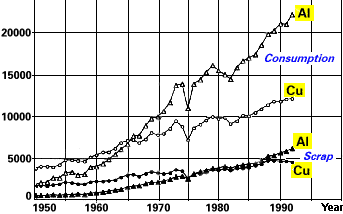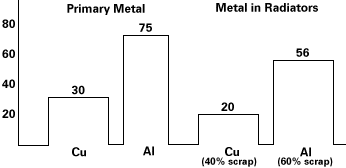- Regaining Market with New Technologies
- The Recycling and Environmental Edge
- Advantage as Primary Metal
- Advantage as Scrap Metal
- Copper's Energy Efficiency
- The Metal for Radiators Today and Tomorrow
- References
Introduction
Summarizing coppers advantages, both as primary metal and recycled metal, for brazed, long-life radiators and radiator parts for tomorrows cars and trucks:
- Virtual 100% recyclability supported by well-established, worldwide reclamation infrastructure.
- Low energy consumption in manufacturing and refining compared to aluminum.
- Superior thermal conductivity, corrosion resistance and strength.
- New no-flux brazing method of assembly.
Copper is used throughout this article to include the primary metal and its alloys.
Regaining Market with New Technologies 
Throughout automotive history, copper has been the metal of choice for car and truck radiators.
This is as true today as ever, even though aluminum has assumed a significant market share in original equipment (OE) radiators over the past 20 years. Copper holds 39% of the total OE radiator market worldwide, and 89% of the aftermarket.
Moreover, with the application of several new technologies to the manufacture of advanced copper radiators, the metal may soon regain shares of the OE market lost to aluminum since the 1970s.
Using no-flux brazing and innovative tube and fin designs, these breakthrough radiators could have a 10-year life and provide up to a million miles of service. Currently being field tested by major automotive companies, they will be 30% - 40% lighter than traditional copper radiators.
In addition, they will be easy to produce because they can be made with the same operations and equipment used for brazed aluminum, thereby eliminating the need for large investments by manufacturers.
The Recycling and Environmental Edge 
Increased interest in copper for radiators is also the result of a growing appreciation among industry experts of the metals environmental friendliness:
- Copper is virtually 100% recyclable.
- Copper has very low energy consumption in manufacture and refining.
The automotive industry, in particular, wants the most environmentally compatible materials and processes for the next generation of cars and trucks. Companies such as Daimler-Benz, for example, are teaming up with suppliers to develop the concept of total metallurgical recycling. Both as primary metal and scrap for and from radiators, copper is a natural fit.
Advantage as Primary Metal 
Coppers inherent superiority in thermal conductivity, corrosion resistance and strength has made it a preferred primary metal for radiators since the dawn of cars and trucks.
Now, with new technologies, it can be used to make smaller, lighter and stronger copper radiators. These radiators will be far more environmentally friendly because they are lead free and easier and cleaner to produce.
Made with a non-toxic, low temperature allow based on the CuNiSnP system, they can be brazed in the same vacuum and controlled atmosphere furnaces used for aluminum radiators and at the same temperature (approx. 600°C). And since flux isnt present, cleaning after brazing isnt needed and no dangerous metals remain in the brazing material.
The radiators will be electrophoretically coated, thereby eliminating the dangers and airborne byproducts of conventional, cosmetic spray painting. The "E" coating enhances their external corrosion protection by providing an even distribution of waterborne paint throughout the entire external structure, including previously unpaintable areas within the innermost recesses of the core.
Advantage as Scrap Metal 
Copper is also superior for radiators because it is one of the most recycled metals in the world and has had a well-established reclamation infrastructure in place for generations. The resultant metal can be remanufactured entirely into new radiators and associated parts.
In the U.S., close to 10% of copper scrap (approx. 70,000 tons) is from radiators. Since roughly 12 million cars are scrapped each year, with an average radiator weight of 6 kg, copper radiator recyclability is close to 100%. Copper radiator scrap usually sells for around 50% of the price of copper and zinc as primary metals.
With advanced radiators, coppers recyclability will be enhanced even further. Made without lead/tin solder, they will be significantly easier to reclaim, and the end product will be far cleaner than in the past. In fact, the recycled copper will be pure enough to fabricate directly into new radiator tube strip. In comparison, brazed aluminum radiators can only be recycled into less critical casting alloy because of their silicon content.
Recycling Statistics 
According to Metal Statistics, more than 10 million metric tons of copper were consumed worldwide in 1991. In the U.S., 43% came from recycled scrap; in Western Europe and Japan, 41% and 39% respectively. Figure 1 compares the amount of scrap contained in total consumption of metals in major global markets. Figure 2 compares copper and aluminum worldwide.
| Metal | U.S. | W. Europe | Japan |
|---|---|---|---|
| Cu | 43% | 41% | 39% |
| Al | 37% | 25% | 31% |
| Zn | 22% | 24% | 16% |
| Pb | 69% | 50% | 16% |
| Sn | 31% | 21% | 12% |
 Source: Metal Statistics , 1992, Metallgesellschaft, Frankfurt am Main, 1993 |
Copper's Energy Efficiency 
Overall energy consumption for aluminum and copper varies from study to study (see Table 1), but the values for aluminum are fairly consistent except in one or two instances where estimates are based on water power electricity and no losses are reported. A normal value for aluminum is 75 MWh/t for primary metal and 5 MWh/t for recycling clean scrap.
| Source See footnotes below | Aluminum | Copper |
|---|---|---|
| Kellogg (1) +(2)(3) |
Ore 69.4 MWh/t Scrap 5 MWh/t |
Ore 0.55% 27 MWh/t Refined scrap 5.6 MWh/t |
| Yoshiki et al (4) +(5)(6)(7)(8)(9) |
Ore 30 MWh/t to 75 MWh/t | Ore 14.4 MWh/t to 49.9 MWh/t |
| Young (10) +(4) |
Ore 64 MWh/t Scrap 15 MWh/t |
|
| Gullman (11) | Ore 26 MWh/t | Ore 8.2 MWh/t |
| Hancock (12) | Ore 85.6 MWh/t Clean scrap 3.6 MWh/t Beverage can scrap 6.8 MWh/t |
Ore 0.50% 29 MWh/t 1.00% 22.7 MWh/t Clean scrap 2.2 MWh/t Refined scrap 5.0 MWh/t Refined scrap 18.4 MWh/t |
| Forrest (9) + (13) |
Ore 75 MWh/t Scrap 4.5 MWh/t |
Ore 0.30% 51 MWh/t 1.00% 25.3 MWh/t Clean scrap 3.6 MWh/t Refined scrap 10.3 MWh/t |
| Arpaci (14) +(15) |
Ore 25 MWh/t to 33 MWh/t |
- Kellogg, H. Energy for Metal Production in the 21st Century: Productivity and Technology in the Metallurgical Industries. TMS-AIME (1989) pp. 145-146.
- Energy Use Patterns in Metallurgical and Nonmetallic Mineral Processing. Phase 4, Battelle, Columbus, NTIS PB-24 (June 27, 1975), pp. 57-59.
- Pitt, C. Wadsworth, ME. An Assessment of Energy Requirements in Proven and New Copper Processes. U.S. Department of Energy Contract, EM 78-S-07-1743, University of Utah (Dec. 31, 1980).
- K. Yoshiki-Gravelsins, J. Toguri, R. Choo. Metals Production, Energy, and the Environment, Part 1: Energy Consumption. Journal of Metals (1993): 5, pp. 15-20.
- Aluminum Industry, Energy Aspects of Structural Change. Office for Economic Cooperation and Development, Paris (1983).
- B. Ilschrer. Materials in the World Perspective: Assessment of Resources, Technology and Trends for Key Materials Industry, Vol l. Springer (1990), New York.
- Bricks, Cooper, et al. Energy Consumption in Industrial Processes. World Energy Conference, London (1989).
- N. Witter, C. Hoskins. Energy Required to Process Ingots, Semis and Finished Products. Metals Technology 11 (1984): 7. pp 302-307.
- D. Forrest, J. Szakely. Global Warming and the Primary Metals Industry. Journal of Metals, 43 (1991): 12 pp. 23-30.
- S. Young, W. Vanderburg. Applying Environmental Life-Cycle Analysis to Materials. Journal of Metals (1994): 4, pp. 22-27.
- L-O Gullman. Energibehov vid framstallning av aluminium och alternativa material. Teknisk Rapport, Granges Essem, LD 823 (1974).
- G. Hancock. Energy Requirements for Manufacture of Some Non-Ferrous Metals. Metals Technology 11 (1984): 7, pp. 290-299.
- P. Chapman, F. Roberts. Metal Resources and Energy. Boston Butterworths (1983).
For copper, energy consumption depends on several factors, including the quality of ore, the type of energy used and the losses involved, but a likely value for typical 0.5% copper ore is 30 MWh/t for primary metal and 3 MWh/t for recycling clean scrap.
Specifically applied to the manufacture of car and truck radiators, copper is even more favorable in terms of energy consumption owing to its high scrap content (see Figure 3). Aluminum, in contrast, is almost three times as energy intensive for use in radiators.
 |
The Metal for Radiators Today and Tomorrow 
Copper has a long history as the best metal for car and truck radiators. Its superior thermal conductivity, corrosion resistance and strength make it ideal for this purpose.
As primary metal, it can be manufactured with relatively low energy consumption into high quality, high performance, weight-competitive and cost-competitive radiators that will last a lifetime for most cars and trucks.
As scrap, it is virtually 100% recyclable and can be remanufactured with low energy consumption into both new radiators and radiator parts.
Aluminum, on the other hand, requires much higher energy consumption when produced as primary metal. And as scrap from brazed aluminum radiators, it can only be recycled as casting alloy. It cannot be re-used in radiators.
With the advent of advanced copper radiators in a world where environmental soundness and recyclability are essential, coppers appeal should grow even more. As a metal for radiators, it can be used again and again.
References 
- Metal Statistics 1992, Metallgesellschaft, Frankfurt am Main (1993).
- J. C. Taylor. The Recycling of Non-Ferrous Metals, Extractive Metallurgy of Copper Nickel and Cobalt. Vol. 1, TMS (1993), pp. 1199-1210.
- K. Gockman. Recycling of Copper. Copper 91, Ottawa TMS (1991).
- Recycling. von Kupferwerkstoffen, DKI 27 (1990).
- Recycling of the Automobile. Automotive Engineering (1993) 10, pp. 42-44.
- B.J. Jody, et al. Recovering Recyclable Material from Shredder Residue. Journal of Metals (1992), pp. 40-43.
- U.S. Bureau of Mines.
- Recycling of the Automobile. Automotive Engineering (1992) 10, pp. 41-57.
- Presenting the Breakthrough No-Flux Brazed Copper/Brass Radiator. International Copper Association, Ltd., New York (1994).
- High Tech Report 2. Daimler-Benz (1994).
